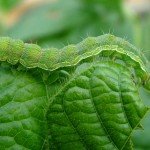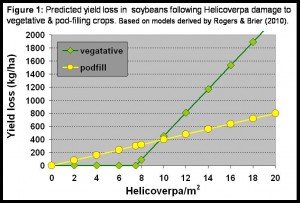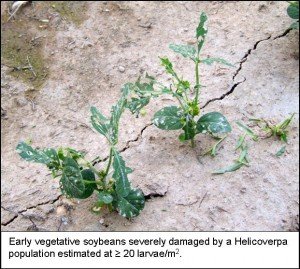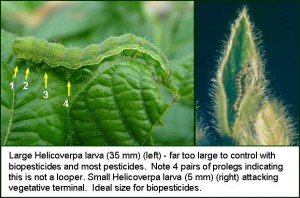
The latest published thresholds for helicoverpa in vegetative soybeans (Rogers and Brier, 2010) show that while soybeans can tolerate damage inflicted by moderate helicoverpa populations up to 7 larvae/m2 without yield loss, severe yield loss is inflicted by populations >7 larvae/m2 at a rate 4-5 times greater than during the pod-fill stage. The conundrum therefore is that while vegetative soybeans are far more tolerant of low to moderate helicoverpa populations (< 7/m2) than podding soybeans, they are markedly less tolerant of populations > 7/m2 than are pod-filling soybeans (see Figure 1).
The reason for this severe yield loss is that unlike most leaf-feeders such as loopers, helicoverpa also attack the plant’s auxiliary buds and vegetative terminals, completely destroying these structures.
Damage to auxiliary buds potentially reduces yield as these structures are the precursors to the plant’s flowers and (subsequently) pods. Damage to vegetative terminals is potentially bad for yield. The reason for this is that while plants may compensate by setting additional side branches, pods formed on these are often closer to the ground and are more difficult to harvest.
Where helicoverpa populations are not excessive, damage is spread over a number of plants and the crop is able to recover and compensate without yield loss.
However, once populations exceed critical level in vegetative crops (about 7/m2), damage per plant reaches a critical level beyond which the subsequent plant growth is severely affected.
To reduce the risk of severe early helicoverpa damage, the sampling guidelines have been revised to “sample crops twice weekly from the seeding stage onwards”. This more-intense sampling regime maximises the chance of helicoverpa larvae being detected while they are still small (ideally <7 mm) and thus able to be controlled with a Helicoverpa virus biopesticide, eg VivusMax or Gemstar.
Remember that the use of biopesticides in pre-flowering soybeans is a key in the “Go Soft Early” strategy to minimise the risk of silverleaf whitefly (SLW) attack in soybeans. The “Go Soft Early” strategy also promotes the build up of beneficial insects attacking other pests such as helicoverpa and loopers.
Vegetative soybean crops can tolerate populations up to 7 larvae/m2 and it is not necessary to kill every helicoverpa larva in a crop. Assuming only 70% control, even populations as high as 20 larvae/m2 can be reduced to below the critical 7 larvae/m2 level in vegetative crops.
Very small plants have fewer nodes and hence fewer auxiliary buds and a given helicoverpa population will damage a greater proportion of auxiliary buds per plant. Severely damaged plants will also be more susceptible to subsequent helicoverpa attack.
Note that small larvae often feed in leaf terminals, so inspect these and look for the tell tale damage symptoms, small holes in the leaflets and frass. For the latest guidelines about applying helicoverpa virus, refer to the previous blog of 8th January 2010. In seedling and early vegetative crops, pesticide costs can be halved by banding the spray over the crop, and blocking off nozzles over the bare inter-row.
References:
Rogers D.J. and Brier H.B. (2010). Pest-damage relationships for Helicoverpa armigera (Hübner) (Lepidoptera: Noctuidae) on vegetative soybean. Crop Protection 29(1): 39-46.
Rogers D.J. and Brier H.B. (2010). Pest-damage relationships for Helicoverpa armigera (Hübner) (Lepidoptera: Noctuidae) on soybean (Glycine max) and dry bean (Phaseolus vulgaris) during podfill. Crop Protection 29 (1): 47-57.
Article by Hugh Brier. Images by Hugh Brier and Joe Wessels




I have seen this occur in the Burdekin over the 2008 summer season – a crop of Leichhardt was totally hammered and never recovered – most lateral braches and flowering sites never eventuated. By the time I got there the helis had been and gone but the damage was permanent.
I also witnessed a very young soybean crop in which the pressure was so high that many of the seedlings were actually ringbarked, resulting in a very poor crop. Again by the time the grower made contact, the damage was done. I discussed this at length with Hugh B
About a week before this article was posted I heard reports of several young soybean crops in the Northern Rivers area of NSW (esp. around the Tweed) that had been severely affected by helicoverpa in the way described in this article. Thanks for the update – I was surprised at the time to hear from my canegrowing friends how damaging helicoverpa could be at this early stage.